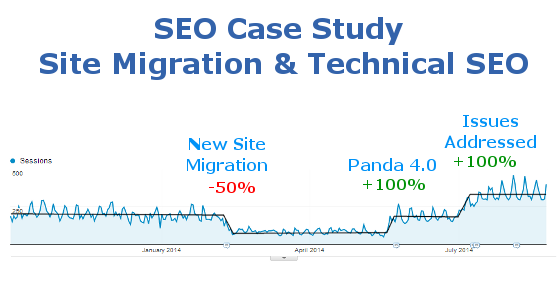Website Migration Technical SEO Case Study
I thought it would be useful to point out an example of the importance of technical SEO, especially when migrating to a new website or platform.
It’s common to rush a new website launch once the development is complete. Additionally, with “content being king,” it’s easy to forget about the importance of technical SEO in addition to the content marketing and creative side of SEO.
Anytime you’re migrating to a new platform, and especially if pages, URL’s, content and structure are changing, the technical SEO considerations should be a priority. SEO is not just title tag optimization and keyword research.
Here is a great example of the importance of technical SEO, outlining the potential for drastic changes in organic search traffic within a poorly implemented migration.
What are common migration issues?
- 404 errors and broken links
- Redirect issues – incorrect use and internal redirect chains
- Accessibility problems and robots.txt issues
- Platform-specific SEO details, such as URL formats, parameters, and pagination
- Base URL formats
- Duplicate content/canonical tag implementation
- Disappearing content, pages or meta information
- Changing internal link structure and content priority
- Removal of sitemap
Website Migration Example
This example is from a project website when I switched platforms. I don’t do much with this website, so it’s a good site to run SEO tests on. While I did have the intention of cleaning up things on the technical side fairly soon, this project was placed on the back burner for a little longer than planned. The website turned out to give me some interesting data on addressing these issues.
Context
The website has a good number of pages and content. During this period, the only change that occurred was the migration to a new platform, and later addressing technical issues.
No page content was significantly changed, aside from internal linking (ie. on-site content, headings, title tags, meta descriptions). No new content was posted during this period, nor were any other considerable potential factors introduced.
The migration that occurred was from WordPress to an e-commerce platform with WordPress installed on the back end in a sub-directory (not sub-domain) to manage much of the websites non-product-based content.
Google Analytics Organic Search Traffic
Migration and Traffic Decrease
The migration took place in early February, and as you can tell, organic search traffic took a fast drop of approximately 50% over a week. After this abrupt drop, traffic remained consistent at this decreased level.
The migration was not totally botched in terms of redirects and changing URL’s, but there were a high number of 404s, platform-specific settings creating potential issues, broken hard-coded internal links, and other items that were not immediately addressed.
The number of url’s also increased due to pages with the same intent created (old pages 404’d due to changing url’s in WordPress, and new url’s with much of the same intent were created.)
Traffic Increase #1
The first significant organic search traffic increase occurred May 19th, 2014, coinciding with the Panda 4.0 update, resulting in approximately a 100% lift. This was not the result of any on-site changes.
Some have stated and experienced softened effects from Panda 4.0 on sites with quality content and technical issues. However, I was not keeping an eye on competitors/rankings during this period, and my traffic increase could have been the result of a few websites being negatively affected by the update.
I do believe this update softened the effects of an ugly site architecture on this domain.
Traffic Increase #2
The next lift occurred directly after addressing a number of on-site technical issues, including 404 errors and redirect issues, content problems, and a number of other platform-specific items.
Again, the result was an additional 100% increase in organic search traffic, and relative to pre-Panda 4.0 traffic, this comes out to be a 200% lift.
A few examples of issues addressed
- Fixed internal broken links, and redirected 404 pages when applicable
- Audited and fixed redirect chains
- Consolidated similar and duplicate pages when appropriate
- Implemented canonical tags
- Updated URL structures to reduce duplicate pages created
- Implemented “follow, no-index” robots tag when appropriate
- Added robots.txt file
- Added an updated XML sitemap
After Panda 4.0 and addressing technical issues, site traffic was back to four times that of the decreased level from early February to late May, 2014.
Conclusion
In this example we can see the organic search traffic return after addressing migration issues, but this may not always be the case. There a lot of things to consider when migrating platforms and new websites from an SEO perspective, especially if organic search is vital to your business.
It’s much better to not risk losing traffic and damaging your website’s organic performance during a migration by planning for changes ahead of time.
Ready To Grow?
Let's Talk!



